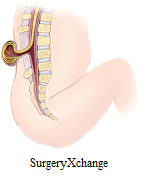Spina bifida is a birth defect which takes place when the spine and spinal cord don't form correctly. It comes under the wide category of neural tube defects. The neural tube is the embryonic construction that ultimately develops into the baby's brain, spinal cord, and tissues that surround them. Usually, the neural tube forms early in pregnancy, and it closes by the 28th day after formation. In babies with spina bifida, a part of the neural tube fails to grow or close properly, causes the faults in the spinal cord and in the bones of the spine.
Types of Spina Bifida
- Meningocele
- Spina bifida occulta
- Myelomeningocele
Symptoms
Following are the symptoms of spina bifida:
- Spina bifida occulta.Since the spinal nerves generally are not involved, typically there are no signs or symptoms. However, evident signs may sometimes be seen on the newborn's skin above the spinal defect, including an abnormal tuft of hair, or a small dimple or birthmark.
- The membranes near the spinal cord push out through an opening in the vertebrae, creating a sac filled with fluid, but this sac does not include the spinal cord.
- In this severe form of spina bifida:
- The spinal canal remains open along several vertebrae in the lower or middle back.
- Both the membranes and the spinal cord or nerves protrude at birth, forming a sac.
- Tissues and nerves usually are exposed, though sometimes skin covers the sac.
Risks include:
- Family history of neural tube defects. Couples who have had one child with a neural tube defect have higher chances of having another baby with the same defect. The risk increases if two previous children are having the same condition.
- Some medications. For example, anti-seizure medications, such as valproic acid (Depakene), seem to cause neural tube defects when taken during pregnancy, possibly because they interfere with the body's ability to use folate and folic acid.
- Women having diabetes with no control over their blood sugar level have a higher risk of having a baby with spina bifida.
- Pre-pregnancy obesity can increase the risk of neural tube birth defects, including spina bifida.
Prevention
Get folic acid first
It is important to have a good amount of folic acid in your system during the early weeks of pregnancy to prevent spina bifida. Most women don't discover that they're pregnant until this time, experts say that all women of childbearing age should take a daily supplement of 400 micrograms (mcg) of folic acid.Various foods, including enriched bread, pasta, rice, and some breakfast cereals, are fortified with 400 mcg of folic acid per serving.
Planning pregnancy
If you are trying to conceive, most pregnancy experts believe supplementation of at least 400 mcg of folic acid a day is the best approach for women planning a pregnancy.Your body does not absorb folate as easily as it absorbs synthetic folic acid, and most people do not get the recommended amount of folate through diet alone, so vitamin supplements are necessary to prevent spina bifida.
To eat a healthy diet, with foods rich in folate or enriched with folic acid. This vitamin is naturally in following:
- Citrus fruits and juices.
- Egg yolks.
- Dark green vegetables.

No comments:
Post a Comment